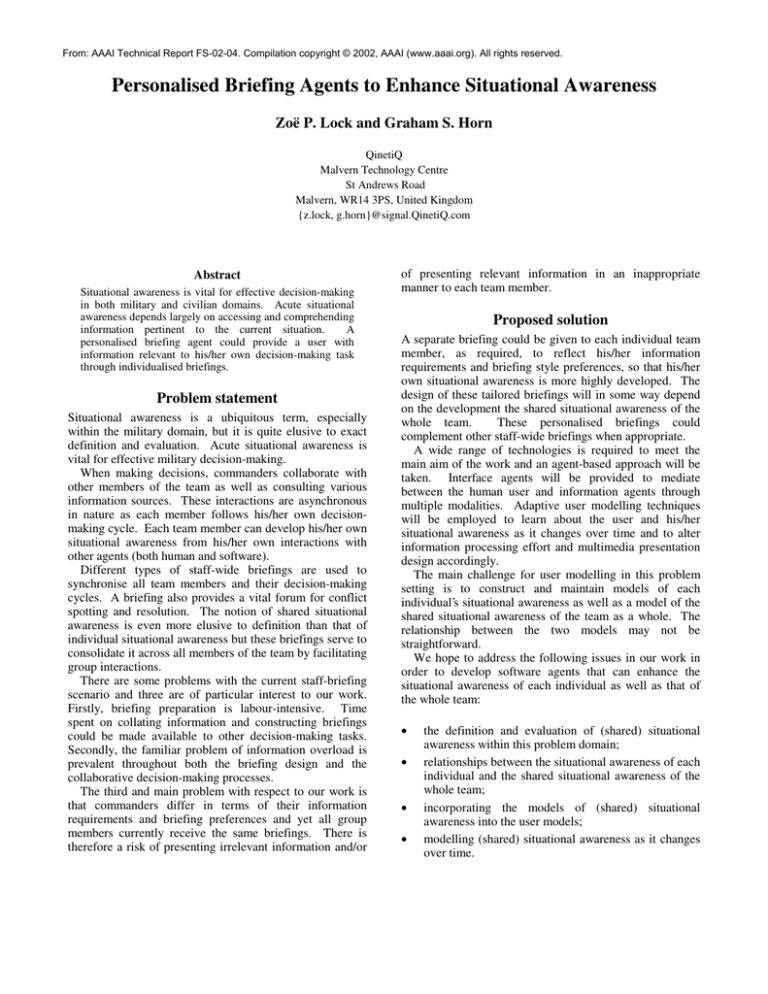
From: AAAI Technical Report FS-02-04. Compilation copyright © 2002, AAAI (www.aaai.org). All rights reserved.
Personalised Briefing Agents to Enhance Situational Awareness
Zoë P. Lock and Graham S. Horn
QinetiQ
Malvern Technology Centre
St Andrews Road
Malvern, WR14 3PS, United Kingdom
{z.lock, g.horn}@signal.QinetiQ.com
Abstract
Situational awareness is vital for effective decision-making
in both military and civilian domains. Acute situational
awareness depends largely on accessing and comprehending
information pertinent to the current situation.
A
personalised briefing agent could provide a user with
information relevant to his/her own decision-making task
through individualised briefings.
Problem statement
Situational awareness is a ubiquitous term, especially
within the military domain, but it is quite elusive to exact
definition and evaluation. Acute situational awareness is
vital for effective military decision-making.
When making decisions, commanders collaborate with
other members of the team as well as consulting various
information sources. These interactions are asynchronous
in nature as each member follows his/her own decisionmaking cycle. Each team member can develop his/her own
situational awareness from his/her own interactions with
other agents (both human and software).
Different types of staff-wide briefings are used to
synchronise all team members and their decision-making
cycles. A briefing also provides a vital forum for conflict
spotting and resolution. The notion of shared situational
awareness is even more elusive to definition than that of
individual situational awareness but these briefings serve to
consolidate it across all members of the team by facilitating
group interactions.
There are some problems with the current staff-briefing
scenario and three are of particular interest to our work.
Firstly, briefing preparation is labour-intensive. Time
spent on collating information and constructing briefings
could be made available to other decision-making tasks.
Secondly, the familiar problem of information overload is
prevalent throughout both the briefing design and the
collaborative decision-making processes.
The third and main problem with respect to our work is
that commanders differ in terms of their information
requirements and briefing preferences and yet all group
members currently receive the same briefings. There is
therefore a risk of presenting irrelevant information and/or
of presenting relevant information in an inappropriate
manner to each team member.
Proposed solution
A separate briefing could be given to each individual team
member, as required, to reflect his/her information
requirements and briefing style preferences, so that his/her
own situational awareness is more highly developed. The
design of these tailored briefings will in some way depend
on the development the shared situational awareness of the
whole team.
These personalised briefings could
complement other staff-wide briefings when appropriate.
A wide range of technologies is required to meet the
main aim of the work and an agent-based approach will be
taken. Interface agents will be provided to mediate
between the human user and information agents through
multiple modalities. Adaptive user modelling techniques
will be employed to learn about the user and his/her
situational awareness as it changes over time and to alter
information processing effort and multimedia presentation
design accordingly.
The main challenge for user modelling in this problem
setting is to construct and maintain models of each
individual’s situational awareness as well as a model of the
shared situational awareness of the team as a whole. The
relationship between the two models may not be
straightforward.
We hope to address the following issues in our work in
order to develop software agents that can enhance the
situational awareness of each individual as well as that of
the whole team:
•
•
•
•
the definition and evaluation of (shared) situational
awareness within this problem domain;
relationships between the situational awareness of each
individual and the shared situational awareness of the
whole team;
incorporating the models of (shared) situational
awareness into the user models;
modelling (shared) situational awareness as it changes
over time.
This work concentrates on the military domain, but the
research can equally apply to civilian briefing scenarios.
Acknowledgements
This work was carried out as part of the UK Ministry of
Defence Corporate Research Programme.
© Copyright QinetiQ ltd 2002
References
Nofi A. 2000. Defining and Measuring Shared Situational
Awareness. Center for Naval Analyses.



